Previous ‘Orphans of the month’Thirteen |
||
Augustus John [1878-1961] Another family portrait by John, of his friend at the Slade Michel Salaman: sadly I have only this photo to go on. However, if you follow this link you will find a photo of a family group, including Michel Salaman, at which he is presented with the portrait by John in 1909. The family photo is also reproduced in the biography of Michel’s son-in-law Alec Guinness by Piers Paul Read. Although the portrait is not that large in the image it can be seen to be more-or-less a profile compared to the near full-face photographic portrait here. |
||||
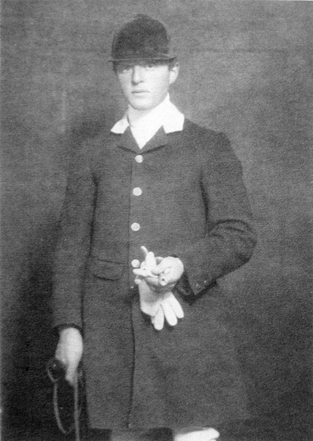 |
||||
Twelve |
||
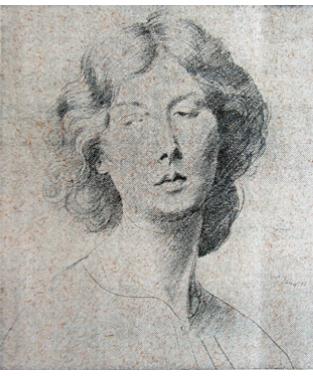 |
||||
Augustus John [1878-1961] Pencil, 322 x 239 mm. Signed and dated ‘08’. Augustus John features elsewhere on this site, but for such a famous artist it is perhaps surprising to come on what seems to be an uncatalogued portrait. This portrait of Chattie Salaman was exhibited in A century of Modern Drawings and Prints, an exhibition held at Thos Agnew & Sons in London from 7 June to 9 July 1971. In his review of the show in The Times the well-known critic and author William Gaunt wrote ‘A contrast in manner though they are, Augustus John’s “Mrs Chattie Salaman” and Wyndham Lewis’s pencil study of a woman both have the distinguished quality the Slade School was able to impart’. This portrait was the only illustraion to his review. It was the only image in the review and I have not seen it illustrated, or for that matter described, elsewhere. It was offered for £500, but I do not know its fate. Chattie’s self-portrait is on this site under Artists S-Z. |
||||
Eleven |
||
Joseph Mordecai (1851-1940) Private collection, 38.5 x 31 cm. If little is known about the artist even less is known about the sitter in Portrait of a young girl which came up at auction in 2008, which is why I have chosen her as this month’s ‘orphan’. His slightly smaller Portrait of a young boy had been sold at auction a year earlier. The son of a merchant, he was most active between 1873 and 1899 as a painter of portraits, genre and literary subjects, living both in London and at Farncombe Manor, Godalming, Surrey. He had studied at Heatherley’s and at the RA schools, exhibiting from 1873 to 1899, at the RA, Paris Salon, the Royal Institute of Oil Painters, Walker Art Gallery and Royal Cambrian Academy. His titles included A Nubian, 1873, and Day Dreams, 1888, while his portrait of Edward VII is in the Royal Collection, though it no longer hangs at St James’s Palace. One of his works, in Leeds City Art Gallery, The Minstrel’s Curse, depicts a King who murdered a minstrel’s son, and another is in the Corporation of London Art Gallery. Further works include My Lady Sweet, The Young Cavalier, portrait of King George, The Princes in the Tower, The Minstrel’s Curse and Portrait of a Lady. The print room at Windsor Castle has a print of a portrait of George V ‘after Joseph Mordecai’, published in 1918. He married Clairibelle Danes about whom little more is known than of this month’s orphan other than that she was also an artist. |
||||
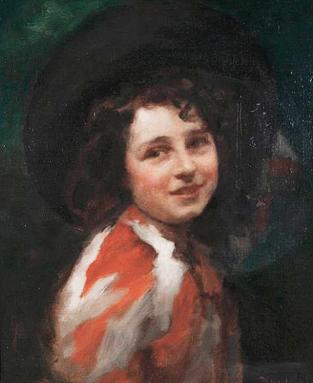 |
||||
Ten |
||||
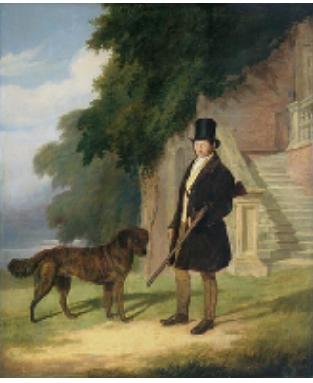 |
||||
Edmund Havell junior (1819-1894) In June it was reported that works of art were either stolen or destroyed when a baying mob ransacked the British Embassy in Libya, closed since the end of February. The paintings, said to be worth more than £130,000, were looted when supporters of Colonel Gaddafi torched the building and vandalised a WWII memorial on 1 May: it was perhaps in revenge for the killing of his son and three grandchildren in a Nato missile attack. Shown here is Edmund Havell jnr’s portrait of William Stratton, head keeper to Sir John Cope of Bramshill Park in Hampshire, which was in the Residence at the time. At the end of August British diplomats arrived back in Tripoli as part of the government’s plan to increase its presence in the Libyan capital. The small Foreign Office team was preparing for the arrival of more diplomats, but no date was then set for reopening the British Embassy and I am not aware of the fate of this or the other works of art. Edmund Havell was a genre and portrait painter and lithographer who frequently exhibited at the RA. He visited America and exhibited at the 1876 Centennial in Philadelphia. He was perhaps the least well known of the Havell family of artists and publishers who flourished from from the late eighteenth century to the 1934. |
||||
Nine |
||
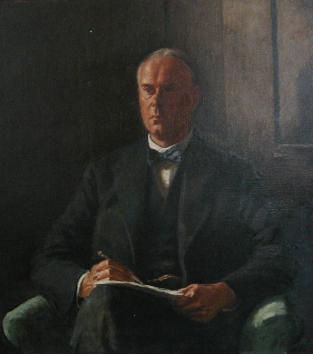 |
C S Orwin MA DLit (1876–1955) I came on this portrait by R Murray some five years ago when I was researching for a showing of the film Twenty-four square miles, based on the book Country planning which he co-wrote with his wife, confusingly also C S Orwin. It was then in the basement of Queen Elizabeth House in St Giles, Oxford which housed the successor body to the Institute of Agriculatural Research which he directed from 1913 to 1946. It has now been demolished and is not in its successor body, so it may be languishing in a University store somewhere. I shall be adding further biographical information later. |
|||
Eight |
||||
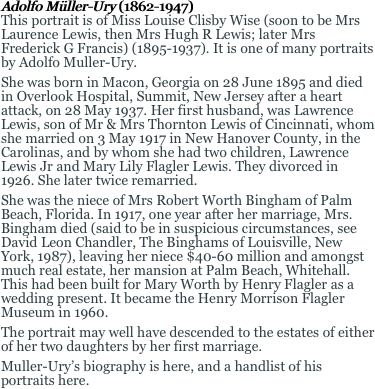 |
||||
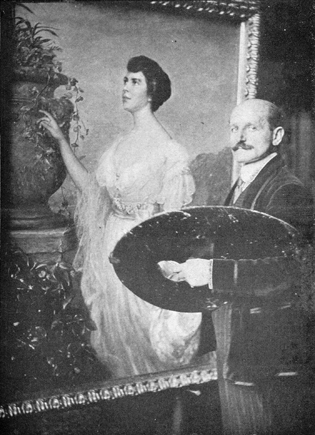 |
||||
Adolfo Müller-Ury ‘completing’ his portrait of Miss Louise C Wise, from the New York Times, 28 January 1917. |
||
Seven |
||
Arnold Henry Mason (1885-1963) 1931, oil on canvas, 42.6cm × 36cm This charming Portrait of a woman is in the collection of Newark & Sherwood Museum Service, to whom I am grateful for permission to reproduce it here, and was donated by the Contemporary Arts Society in 1963. It is not a missing portrait, but rather another unknown sitter, so if you know who it might be please leave me a message. As well as this portrait his work is to be found in the NPG (Elinor Glyn, 1942), the Tate (Girl with a Hand-Mirror, 1929), Hull University (Head of a Child) and the Queen's Collection (of his Slade friend Winifred Knights, pre-1920) and private collections. His portrait of Wallis Simpson, later Duchess of Windsor, is presumably not in the Royal Collection, but at Christie's South Kensington in 1999 it would have been a bargain addition for £207 … Mason studied first at the Macclesfield School of Art, then the RCA and Slade, and in Paris and Rome. In World War I he served in the Artists Rifles. He showed at the RA from 1919, became an ARA in 1940 and an RA in 1951. He worked in the south of France and exhibited widely in both London and the provinces. ‘His portraits, often of head and shoulders, present a realistic, firmly modelled account of his subject. His painting technique could be broad, working in large areas of light and shadow, particularly in his paintings of Provence, but many portraits show a more detailed approach, although still retaining a freshness of brushmark and a sense of life’.* His portrait was painted by Clifford Hall, but I feel that Mason might have done better himself. |
||||
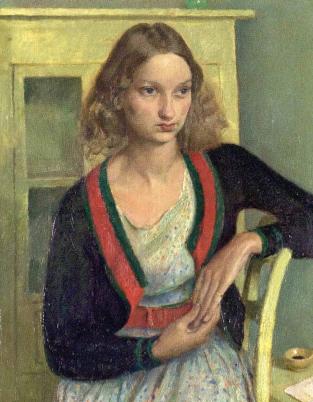 |
||||
*Handbook of modern British painting 1900-1980, ed Alan Windsor. Aldershot, 1992. |
||||
Six |
||
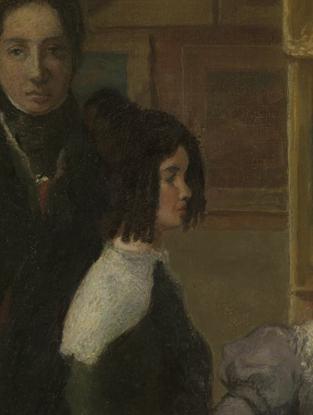 |
John Scarlett Davis’s painting, in the Yale Center for Bristish Art, depicts an art exhibition in nineteenth-century London. The figures in the foreground are all copies after pre-existing portraits, predominantly those by Sir Thomas Lawrence. All of the portrait sources have been identified, save one: the girl in the family group at right, shown in profile. The precision with which Davis delineates her high hairstyle with its tight curls contrasts with the relative lack of detail in her stiff green dress, suggesting that perhaps the artist was looking closely at a bust-length portrait for which he then invented a body. She stands between the art collectors John and Louisa Harford; their likenesses were based on portraits painted by Lawrence five years earlier. While she is often thought to be their daughter, the couple had no children. The figure may represent Eleanor Dundas Harford-Battersby, the Harfords’ niece, who was eleven years old in 1829. She was the daughter of John’s brother Abraham Gray Harford-Battersby and his wife Elizabeth. After the death of her mother in 1823, the childless Harfords played active role in her upbringing and that of her siblings. Yet no matching portrait of Eleanor Dundas Harford-Battersby has surfaced. Has anyone seen this girl? If so, please leave a message. The portrait bust at left in the main picture (formerly thought to be Sir Francis Chantrey’s portrait of the Marquess of Stafford, later created Duke of Sutherland), is also unidentified and I would be grateful for any theories on its identity, as well. |
|||
Five |
||
Sir Lionel Abrahams [1869-1919] Reproduced just once that I know of, shortly after the sitter’s death, this is yet another portrait by the unrelated I M Cohen. Of Sir Lionel a colleague at the India Office wrote to The Times: The … death of Sir Lionel Abrahams has deprived the India Office of an outstanding personality. Very soon after his entry into the Civil Service in 1898 [he] impressed … by the remarkable gifts which he showed for finance in all its branches … While still in his early thirties [he] was appointed to the post of Financial Secretary … It was a great distinction for a man so young to be selected for the post, the holder of which is the principal financial adviser of the Secretary of State for India in Council. The success with which Mr Abrahams, carried out the duties, … was recognised by the grant … of the KCB, and by his selection to serve on numerous special committees, some of which were outside the ordinary functions of the India Office … The rôle Sir Lionel filled in the India Office was a unique one, in a large measure carved out for himself by his own genius and imagination. The work he undertook was of such scope and volume that no one but an enthusiast—and Sir Lionel was such for India and Indian finance in particular—could have faced. Unhappily the strain proved too great for a man of delicate constitution. The loss of an only son in action was a blow from which he never recovered, and cast an ever present shadow over his last months, in which he struggled manfully against failing health. Now his desk will know him no more. The writer was presumably Sir Cecil Kish, who was ‘connected’ to Lionel Abrahams, having married his wife’s brother’s wife’s sister … |
|||
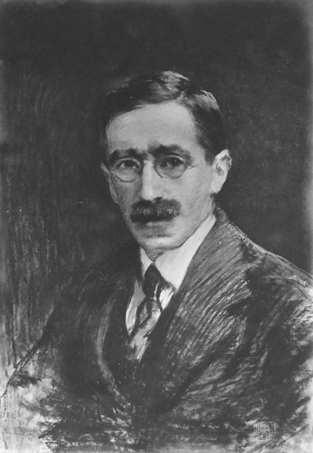 |
|||
Four |
||
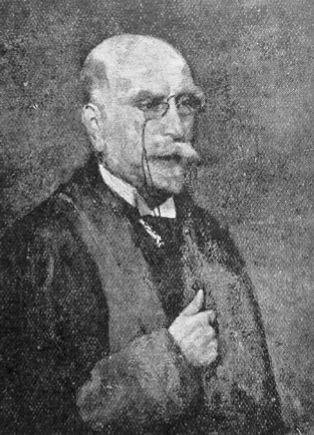 |
||||
Delissa Joseph Joseph was not a modest man, he laid claim to have designed as many streets in London as Nash, and to have demolished a Wren church; this he ‘expiated’ by setting a plaque in the wall of the new building. This portrait is by his wife Lilly, who took on his given name (which would once have been de Lisa or de Lissa) as well as his family name, hence Lilly Delissa Joseph. I have found a reproductions of one photo of him and of this portrait by his wife, surprisignly little for a man not shy of the limelight. |
||||
Three |
||
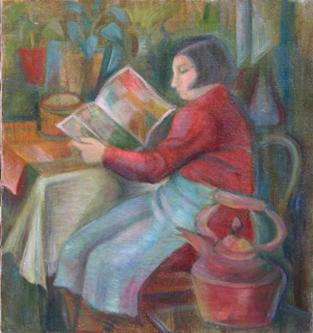 |
||||
My third orphan marks a slight change of emphasis. Ruth Collet was a cousin of my father and at the Slade with my mother. Rather than the location being unknown, it is the sitter in Woman in an interior, reading who is not known. |
||||
Two |
||
My second ‘Orphan of the month’ is another great grandfather, Nathan S Joseph [1834-1909], drawn by the Australian portraitist Isaac Cohen to whom I am not related. The reproduction is taken from A century of social service, 1859–1959: the Jewish Board of Guardians [V D Lipman. London, 1959]. It records that ‘in 1861 the 26 year old Nathan heard a sermon at the Central Synagogue by Rev A L Green who suggested that some of the young Jewish gentlemen living in the West End would regularly visit the Jewish poor in the East End. Nathan joined the Visiting committee’. It continued ‘The vestries had the duty of appointing medical officers of health and inspectors of nuisances, but their activities were limited by the influence of the vestrymen and the number of inspectors was generally inadequate. The Board of Guardians found the City of London administration efficient, but otherwise it was in uphill job to get local authorities to carry out their statutory functions. The suggestion which Joseph put forward, and which the Board adopted, was that the Board should appoint a sanitary inspector to inspect houses, to press for the remedying of defects, and to get landlords and local authorities to fulfil their responsibilities. The very use of the term ‘sanitary inspector’ is an indication of the way in which the Board were ahead of their time. The statutory officers, subsequently designated sanitary inspectors (now public health inspectors) were then known merely as inspectors of nuisances. The Board’s sanitary inspector's duties were to inspect and report on sanitary defects of houses of the poor who were on the Board’s registers; and to set the appropriate laws in action to remedy defects of drainage, water supply, gullies, and accumulated refuse. During 1865 and 1866, at least he proved very useful indeed. In the first six months he inspected 471 houses (comprising about 14,000 tenements) and found sanitary defects in 343 of them. The houses he inspected covered half the dwellings occupied by the Jewish poor under the care of the Board. It was a result, partly at least, of the sanitary inspector's activities that the Jewish poor did not suffer so much from the 1865 fever and 1866 cholera epidemics as did their neighbours. Other steps taken by the Board in the 1866 epidemic were to erect 27 stand pipes for pure water; and to arrange for the removal, boarding out and re-equipping of infected families while their houses were cleaned, disinfected and whitewashed, and their bedding destroyed’. |
||||
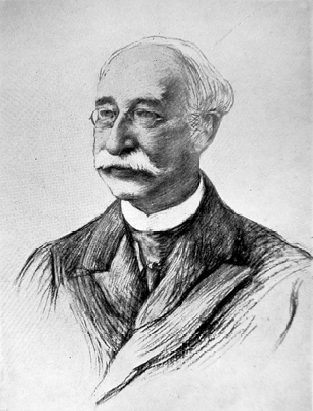 |
||||
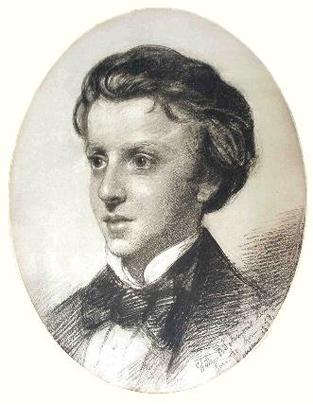 |
||||
The first ‘Orphan of the month’ is my great grandfather, Myer Salaman [1836-96], drawn by his first cousin Rebecca Solomon in 1852. This portrait is known from several prints in the family [45 × 35 cm], but it seems to have escaped the notice of authorities on the Solomon family of painters, Abraham [1823-62], Rebecca [1832-86] and Simeon [1840-1905]. At the time she was 20 and he was only 16: the inscription at the bottom right reads ‘With R Solomon’s kind love to her cousin 1852’. Later, at the time of his ‘fall’, Myer was to stand bail for Simeon. Myer took over his father's ostrich feather business and with his brother built it into a world-wide multi-million pound business. Much more information is available here. According to my father 'he was a very loveable man, a voracious reader of Shakespeare and Dickens, and an encourager of the young who gathered at their (then) ‘country place’ at Mill Hill. The ‘young’ included Orpen, McEvoy, A[ugustus] John and Ida [Nettleship], [Israel] Zangwill, [Sir] Will Rothenstein etc'. |
||||
|
|||

